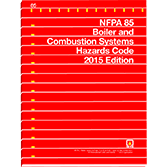NFPA (Fire) 85
Click here to purchase
Improve fire safety and system reliability with the 2011 NFPA 85: Boiler and Combustion Systems Hazards Code.
Updated for 2011, this comprehensive document applies to the full range of large boiler installations and pulverized fuel systems:
- Large boilers, including atmospheric fluidized bed boilers with a minimum fuel input rating of 12.5 million Btu/hr (3.6 MW)
- Stoker operations
- Pulverized fuel systems
- Fired or unfired steam generators used to recover heat from combustion turbines
Major changes for 2011 include:
- New definition and rules for a Combustion Turbine Purge Credit enabling designers and operators to establish and maintain a “purged” condition for heat recovery steam generators between restarts
- Streamlined requirements for continuous trend display for single burner boilers
- Revised boiler requirements for purging the boiler enclosure where no fans remain in service
- Expanded guidance on burner management system design describes the types of signals and transmitters used to initiate safety alarms and interlocks and appropriate monitoring methods
- Added guidance regarding flue gas analyzers installed in the flue gas stream
Product Details
- Published:
- 12/14/2010
- ISBN(s):
- 9781616657048
- Number of Pages:
- 241
NFPA (Fire) 85
Click here to purchase
Help protect facility occupants and maintenance personnel by remaining up to code on the design, installation, and inspection of large boilers and combustion systems. The new edition of NFPA 85, Boiler and Combustion Systems Hazards Code is the definitive guide for meeting compliance requirements and addressing the most current fire safety concerns for designers, operators, facility managers, and enforcers. (Softbound, 233 pp., 2019)
Product Details
- Published:
- 03/01/2019
- ANSI:
- ANSI Approved
- Number of Pages:
- 240
NFPA (Fire) 85
Click here to purchase
In response to newly identified fire safety concerns, the 2015 NFPA 85 presents updated requirements for boiler and combustion systems.
Boiler hazards not only impact operational performance, they can cause explosions and jeopardize the lives of facility occupants and maintenance personnel. Revised for 2015, NFPA 85: Boiler and Combustion Systems Hazards Code gives everyone involved with large boiler installations and pulverized fuel systems the information they need for fire safety compliance — from design and installation to inspection.
NFPA 85 presents requirements for the full range of equipment:
- Large boilers, including atmospheric fluidized bed boilers with a minimum fuel input rating of 12.5 million Btu/hr (3.6 MW)
- Stoker operations
- Pulverized fuel systems
- Fired or unfired steam generators used to recover heat from combustion turbines
Major changes in the 2015 edition of NFPA 85 include:
- New requirements to facilitate safe purging of fuel gas piping in and out of service, including requiring a designated equipment isolation valve, purging upstream piping in accordance with the applicable standard, and minimum safety requirements for purging piping and equipment downstream of the equipment isolation valve.
- Several provisions concerning multiple burner boilers (formerly in Chapter 6) were relocated to Chapter 4, General Requirements to indicate they apply to all equipment under the scope of NFPA 85. Relocated requirements include conducting a process hazard analysis for unattended operation, restrictions on removing interlocks from service during startup or operation, and preventing the flow of flue gases from a common stack into an idle boiler or Heat Recovery Steam Generator (HRSG).
- Safety-rated programmable logic controllers are recognized in the Code for use with single-burner boilers where they are certified as at least SIL 3-capable according to IEC 61508.
- Chapter 9, Pulverized Fuel Systems, was completely rewritten to separate requirements for direct-fired and indirect-fired systems to help users identify and apply requirements for specific equipment.
Product Details
- Published:
- 12/01/2014
- ISBN(s):
- 9781455910380
- ANSI:
- ANSI Approved
- Number of Pages:
- 241




